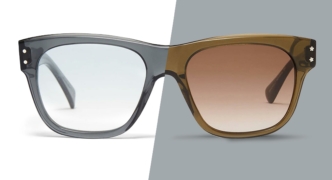
The right pair of glasses can make it easier to look at computer or device screens with less eye strain. Depending on vision needs, prescription computer glasses with one or more areas of focus may be helpful. Prescription or standard lenses for computer use may filter out blue light. Prolonged exposure of the eyes to high-energy visible light can cause computer vision syndrome and disrupt circadian rhythms. Eyewear that limits exposure to blue light may be helpful with or without corrective lenses.

Corrective Glasses for Computer Use
Prescription glasses for computer use are available with several lens types. Monofocal or single-vision lenses make it possible to see a screen clearly with minimal head movement. Objects that are closer, such as notes on a desk, will be blurry. Bifocal, trifocal or progressive lenses are ideal for focusing at more than one distance while working on a computer.
Lenses for Filtering Blue Light
Many glasses for computer use filter out high-energy visible light. Hours spent staring at screens that emit blue light can strain the eyes. Glasses with lenses that filter blue light allow enough visible light to pass through the lenses to prevent color distortion. These glasses often have anti-reflective coatings and are designed to increase contrast.

FAQ
Do computer glasses have a prescription?
Glasses intended for wear while using backlit screens are available with or without corrective lenses. Prescription glasses may be monofocal or have bifocal, trifocal or progressive lenses to improve near vision as well as sight at distances that exceed the intermediate range of the screen.
A prescription is not necessary for computer screen glasses that filter out blue light and glare without vision correction. When it comes to selecting glasses for limiting exposure to blue light, lens color can be the most important factor. This type of glasses may have amber-colored lenses or coated clear lenses that only reflect colors.
What are prescription computer glasses?
Computer glasses with prescription lenses improve the clarity and quality of vision and may also filter out blue light. Single-vision prescription glasses are useful for wearing to look at a computer screen. If you need to look down at a keyboard or other items on a desk, bifocal lenses may be useful.
Trifocal or progressive glasses can be the best options for correcting vision and preventing eye strain in environments that require multiple areas of focus. Although trifocal glasses provide more of a full range of vision correction, the viewing areas are limited. Progressive lenses without lines have similar characteristics.
Do computer glasses really work?
Glasses designed to be worn while looking at screens are effective for the specified purposes. Prescription computer glasses make it easier to read text and distinguish details on a computer screen. Lenses that have multiple areas of focus make it easier to use computers while also improving near or extended intermediate vision.
Computer screen lenses designed to filter out blue light can minimize eye strain. Continued comfort throughout hours of screen time is the most important factor for glasses for computer use with or without prescription lenses. Make sure that tinting is suitable for light levels in a work environment.





























